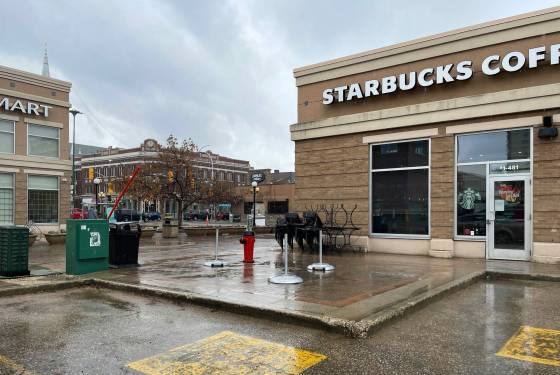|
“I applied for a job at Starbucks. One of the questions was, ‘Why do you want to work at Starbucks?’ Uh, because my life is in shambles.”
— comedian Hannibal Buress
The Macro
When the sudden news came that the Starbucks in Picton, Ont., had closed, I didn’t know how to feel.
There is certainly no shortage of local coffee shops in my new, adopted hometown. There is Lily’s Café, which has great snacks and is connected to an unusually large book shop. The Bean Counter is an excellent place to grab a shore lunch when heading out to the Sandbanks Provincial Park. And the Beacon Bike + Brew — my current fave — not only sells a broad array of locally roasted beans (shout-out to Quietly Coffee roasters from nearby Stirling) but also sells and repairs bikes.
Still, when I first moved here, I spent a fair bit of time at the Starbucks because — well — it had way better WIFI and we had yet to move into our new rental. After we took up official residence, I didn’t go to the Starbucks much.
Advertisement

Back in September, as I looked at the store where the signage had been ripped down and craft paper covered the windows, I immediately thought of Bart Simpson.
You may remember that in 1998’s season nine, episode 19, Bart Simpson goes to the Springfield Mall to get his ear pierced at In ‘N’ Out Ear Piercing, which promised would-be customers, “If it dangles, we’ll punch a hole in it.” On his way to the In ‘N’ Out, viewers see that every other store in the mall is either a Starbucks or an empty storefront promising the arrival of another Starbucks.
When Bart asks to have his ear pierced, the store worker tells him, “Better make it quick, kiddo. In five minutes, this place is becoming a Starbucks.” Bart leaves the store shortly thereafter, stud sparkling in his left ear, drinking a cup of a Starbucks coffee.
Boy, was that then.
The September shuttering of the Starbucks in Picton was not an isolated event; the company announced it was closing more than 400 stores across North America. The company still operates more than 18,000 locations, but these closures — more stores were shut down in 2024 — is surely the latest sign one of the world’s most resilient hospitality brands is facing an uncertain future.

The Starbucks location in Osborne Village was closed in 2024. (Ruth Bonneville / Free Press)
I wrote about this last year in a previous newsletter when the Starbucks in Osborne Village closed suddenly and — to my frustration — without a clear explanation why. This closure took place during a period in which safety in Osborne Village was being questioned. Starbucks never directly pointed to the issue of safety as the reason why it closed up shop at the River and Osborne location. But, then again, they didn’t say it was part of a broader corporate strategy to find more profitable locations. Which, when you look at other locations in Winnipeg that were shut down, seems more likely.
Starbucks also closed locations at Donald Street and Broadway, and on Academy Road. What do these locations have in common with Osborne Village? None had drive-thru windows. Just saying.
Honestly, and not just because of the sudden closure of stores, it’s becoming harder and harder to justify a trip to any Starbucks. If the cynical and somewhat mysterious circumstances of store closures isn’t enough to motivate you to support local, independent coffee houses, then perhaps you could find solidarity with Starbucks workers.
This week, more than 1,000 workers walked off the job and protested outside 65 stores across the U.S. to protest unfair labour practices. The “Red Cup Rebellion” as it is known among employees, is seeking improved wages and benefits. In the past few years, about 650 Starbucks locations have unionized and talks for a new contract broke down earlier this year.

Protesters picket outside a Starbucks on Nov. 13, in Philadelphia. (Matt Slocum / The Associated Press files)
One of the only reasons I could support Starbucks in the past was that I thought it paid better wages and offered benefits. What I’ve learned is that wages have not kept track with inflation and the company has a habit of holding its employees to less than 20 hours per week — the threshold for benefits.
Here’s the really bad news for Starbucks. Local coffee houses have proven they can not only survive but thrive in competition with behemoths like Starbucks. The indies have no doubt benefited from the fact that Starbucks helped establish an outrageous market price for espresso drinks. If you’re willing to pay $7 for a large latte, why not get one at a shop owned by your neighbour’s daughter?
So, with lots of local options to choose from, and my current obsession with finding locally roasted coffee, I’m swearing off Starbucks once and for all with the hope that locally owned coffee shops continue to thrive. So much so, we might see them popping up in the now-empty Starbucks stores that populated the Springfield Mall.
|

